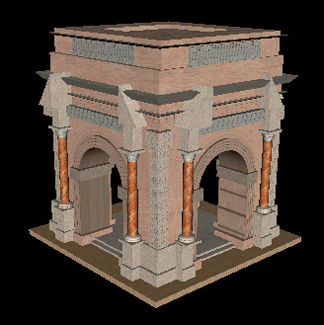3D Animation Workshop: Lesson 45: VRML--Embers in the Ashes webreference.com
|
|
Lesson 45 - VRML--Embers in the Ashes - Part 2
This first image is from Cosmo Player 2.1 and the second is from the Microsoft VRML browser.


The lighting is miscalculated and the elegant textures are either missing or corrupted in the second image. A beautiful model, rich in detail, has been savaged. Nor do these still images convey the full weight of the problem. Navigating around this scene in Cosmo Player is smooth and satisfying. In the Microsoft VRML browser, the colors flicker and often change drastically from different viewpoints. I've tried the Microsoft browser with graphics hardware that supports Direct 3D (the Microsoft standard), and the improvement, if any, was barely discernible.
I hate to say it, but it gets worse. The Mircosoft VRML broswer simply rejected the simplest Javascript routines I wrote, and which ran perfectly in Cosmo Player. Without reliable script execution even the simplest professional content development is hopeless. In fact, pretty much all of the high-end content I tested on the Microsoft product was seriously degraded or worse. Files with MIDI sound are not supported in the Microsoft VRML browser, and thus the most practical means of providing audio in VRML files is unavailable. I could go on and on, but you get the idea.
I stress all this because, if VRML is to survive, there must be a free, widely-distributed VRML browser with at least minimally satisfactory capabilities. Individuals and businesses can do all the content development they want, but there must be some large commercial enterprise that is willing and able to develop and improve the viewing platform and distribute it for free. The loss (if it ultimately occurs) of Cosmo Worlds as a VRML development tool would be devastating for many reasons. But the loss of Cosmo Player, or of the continuing effort to improve it, could realistically spell the collapse of VRML.
I am a strong believer and supporter of Microsoft, and am not embarrassed to say so. Windows NT has made professional 3D graphics and animation affordable to artists and revolutionized the computer graphics landscape generally. The Microsoft Web browser, Internet Explorer, is my browser of choice. But Microsoft has never taken VRML seriously. Their VRML browser was developed by Intervista and included as an add-on without "standard installation" status. This browser is almost a year old, and anyone who remembers the Cosmo Player of a year ago knows how greatly it has been improved. Microsoft simply left the field to Cosmo Software.
Will this now change? Will Microsoft--the only company capable of developing and distributing a VRML platform--embrace VRML? And if they want to do so, why didn't they buy Cosmo themselves? One may be tempted to read important consequences into the recent notice that Kai-Fu Lee, the former president of Cosmo Software, is taking a job as director of Microsoft's advanced interactive systems. But this may mean nothing for VRML.
The future distribution of the current version of Cosmo Player, through the Netscape site perhaps, or as part of a standard software installation by the large computer manufacturers, would not address the larger problem. Once a product is no longer being supported and upgraded, it makes little sense to invest one's energy in it. Cosmo understood this very well, having focused considerable effort into upgrading the Cosmo Player and persuading the development community that the platform was rapidly maturing. Everything about the computer industry (and particularly the Internet) is future-oriented. Today's technology is already old.
So is the situation completely hopeless?
| To Continue to Part 3, or Return to Part 1, Use Arrow Buttons |
|
Created: July 21, 1998
Revised: July 21, 1998
URL: https://webreference.com/3d/lesson45/part2.html


 Find a programming school near you
Find a programming school near you